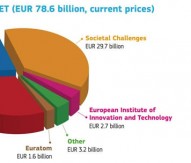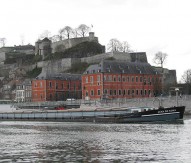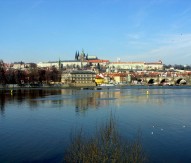
Romania first to unveil H2020
Romania has become the first EU member state to launch Horizon 2020. The event took place last week at the National Library in the capital Bucharest and was attended by European Commissioner for Research, Innovation and Science, Máire Geoghegan-Quinn. The Eastern European country, which joined the Union in 2007, has participated in several previous framework programmes, yet still suffers with the lowest R&D intensity of 0.47% (2010).
In her first visit to Romania as a European Commissioner, she drew attention to Horizon 2020 being the only major EU programme that will see “an increase in resources” under the next 2014-2020 Multiannual Financial Framework, and equal to a 25% real terms increase compared to FP7. Geoghegan-Quinn began by outlining the priority of simplification in one of the world’s largest public R&D programmes.
“It has been a top priority to make it easier for our scientists and business people to access EU funding. Unnecessary red tape meant they spent too much time on administration.
“While the current generation of programmes have lots of different rules, Horizon 2020 applies the same rules everywhere. That means it is much easier to apply and participate in projects. The reimbursement of project costs will be much simpler with a single reimbursement rate for most projects. That means less paperwork and fewer audits. Furthermore, under Horizon 2020, the time between sending an application and receiving a grant will be much quicker. This means great projects will be able to get up and running many months earlier than under the current system.”
Horizon 2020 will combine the elements of the exiting Framework Programme for Research and Development, the innovation related activities of the Competitiveness and Innovation Framework Programme and funding for the European Institute of Innovation and Technology. This consolidation will bring coherency to RDI investment, from fundamental research to the development and launch of new products.
Societal Challenges
Horizon 2020’s third pillar will centre on tackling the major challenges facing the future of European society, as Geoghegan-Quinn continued.
“Horizon 2020 will take a challenge based approach. This is because the challenges facing Europe, whether food and energy security, clean transport, public health or security, cannot be solved by a single field of science or technology, let alone a single sector, or a single organisation. These complex challenges will need solutions that draw upon many different areas of research and innovation. That’s why interdisciplinary is such a crucial aspect of Horizon 2020. We will encourage researchers to get out of their silos and we expect that broader societal aspects are addressed by embedding the Socio-Economic Science and Humanities across the whole programme.”
Business partnership
Horizon 2020 is encouraging more businesses to become involved, with particular financial assistance devoted closer-to-market activities and encouraging entrepreneurship. More public private partnerships will also be introduced, as Geoghegan-Quinn continued.
“Five PPPs (dealing with innovative medicines; fuel cells and hydrogen; aeronautics; bio-based industries; and electronics) are expected to mobilise up to around €22bn of investments, with €8bn coming from the EU. These partnerships offer huge opportunities for companies and researchers right across Europe, including SMEs.
“Research and innovation for SMEs are promoted across Horizon 2020 as a whole, but we are also introducing a new instrument that is adapted to their specific needs. This will allow single SMEs to receive small, simple grants for highly innovative projects.”
Widening participation
Increasing the range of participation in Horizon 2020 is a core target of the framework programme, which will aim to “bridge Europe’s innovation divide,” particularly between Eastern and Western Europe. The framework programme introduces three schemes aimed at overcoming this divide, as well as supporting scientific excellence and the innovation capacities of emerging institutions.
“‘Twinning’ aims to significantly strengthen an emerging institution’s capacities in a specific field of research through co-operation with at least two internationally renowned counterparts in Europe. ‘Teaming’ actions aim to create new Centres of Excellence on greenfield sites or through major upgrades in partnership with leading research counterparts in Europe. The ERA chairs will bring outstanding academics to institutions in regions that may not have been so successful in securing EU funding, but have high potential for research excellence. They will help their host institutions to fully unlock this potential.”
National focus
In the EU’s 2013 Innovation Union Scoreboard, Romania was described as a ‘modest innovator’ the lowest mark on the four-point scale. Horizon 2020 promotes “excellence, innovation and economic impact,” three elements the country “badly” needs.
“The best way for Romania to accelerate the impact of its investment in R&D is through international co-operation. This is especially true for Romania’s private R&D investments, which are concentrated in particular sectors, such as automobiles, ICT, new production technologies and security.
“Horizon 2020 will fund research and innovation areas that align with Romania’s priorities. These include smart specialisation, tackling societal challenges, SME participation, synergies between research, innovation and industry, and a stronger focus on impact and results.
“Under FP7, Romania has been most successful in the areas of ICT, transport, nanotechnologies and nanosciences as well as environment, health and security, and research for the benefit of SMEs. Capitalise on this and build on your science and technology potential in these areas, while striving to maximise opportunities in new areas of research and innovation. Considering your strength in basic research, Romania certainly has scope to increase its participation in the ERC and Marie Skłodowska-Curie Actions, where you have not been so active so far.”
National changes
The Commissioner called for Bucharest to place greater focus on R&D in order to improve national research and innovation capacities, as well as develop synergies between research, innovation and industry through the new national strategy, therefore helping to attract private R&D investment. Geoghegan-Quinn highlighted the need for national reform in order to encourage economic growth and create jobs, core aims of the European Research Area and Innovation Union. She said efficiency, effectiveness and simplification were key to helping build a solid economy.
“I am calling on Romania’s researchers and universities, its businesses big and small, its academic and its innovators: get involved! Find out how to participate, build on your contacts with your peers in the rest of Europe, and don’t be afraid to think big, because Horizon 2020 is about big opportunities and big results. Step up to the challenge, find the opportunities and reap the rewards of Horizon 2020.”
Events will be held across the EU and the wider world to launch Horizon 2020 at a national level throughout the coming months, in addition to the announcement of the first calls. Horizon 2020 will formally replacement FP7 on 1 January 2014.




